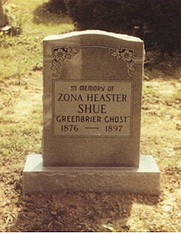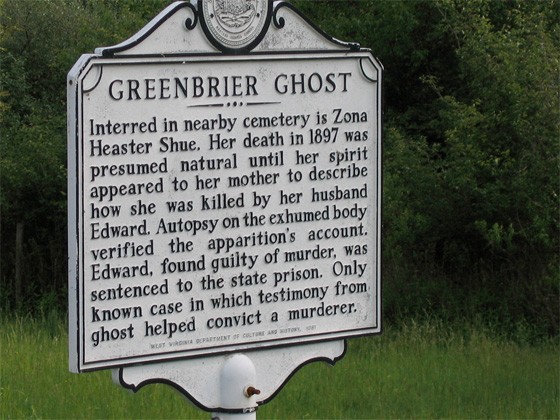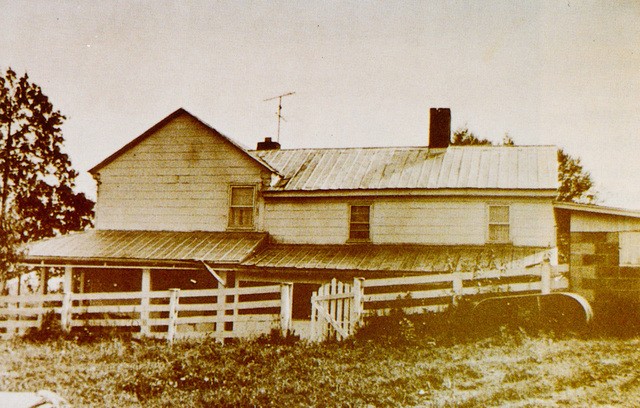Greenbrier Ghost Historical Marker
Introduction
Text-to-speech Audio
Images
Zona's Tombstone.

West Virginia historical marker located near the interstate shares a brief summary of this mysterious event.

Zona Heaster Shue (1876-1897)

A vintage photo of the Shue House.

Backstory and Context
Text-to-speech Audio
The tragic and bizarre case of the Greenbrier Ghost trial began when Edward Shue arrived in the area seeking work as a Blacksmith. A local girl by the name of Zona Heaster fell in love with the newcomer, and the pair were soon wed. Reportedly the marriage did not sit well with Zona's mother, Mary Jane Robinson Heaster.
Zona and Edward lived together for a short time before her death on January 23, 1897. On that day, a young boy found Zona's lifeless body in her home while running an errand. At the time, the boy found Zona's body at the bottom of a staircase. He later testified that she was positioned oddly with her feet together one hand on her stomach and the other lying beside her.
The town physician, Dr. George W. Knapp, was asked to look at the body but he did not arrive for nearly an hour. The trial later revealed that during this hour, Edward had already taken his wife upstairs to the bedroom, cleaned her, changed her into a high neck dress with a veil, and positioned her peacefully on the bed. Dr. Knapp's examination was short since Edward was sobbing over his loss and would violently react when the doctor tried to take a closer look at the body.
While the husband's actions might trigger an immediate criminal investigation today, the tradition of patriarchy where a husband was considered the sovereign leader of a household led the physician to defer to Edward. Violence by husbands against their wives was more common, but discussing the issue was taboo leading to a widespread lack of awareness of the often deadly consequences of domestic violence.
In addition, it was easy for the doctor to assume that Zona had died of natural causes even though she was young because he had been treating her for several weeks for an unknown ailment related to obstetrics or gynecology. In the 19th-century, few physicians were experts in these fields, and Zona may have been pregnant or the victim of sexual abuse. In many of these cases, the failure of physicians to adequately diagnose women led to additional complications and could even lead to death. Until the 1920s, and even beyond, physicians often prescribed opiates to their female patients that masked the underlying causes of their health issues and led to addiction. Medical advances dating back to the antebellum period should have provided physicians with more knowledge, but patriarchy and Victorian mores combined to make discussion of the subject taboo even in many medical communities.
Dr. Knapp sent riders out to Zona's parents to tell them of the news. Upon hearing the news Mrs. Heaster said, "The devil has killed her." Zona had long suspected her daughter was in an abusive relationship, and her subconscious thoughts likely led to her dreams where her daughter confirmed her suspicions.
Soon after her death, Edward took care of every detail of the wake and burial. Few other than Zona's mother suspected anything when the body was buried in the meadows. Mrs. Heaster took the sheet from the coffin before it was buried and tried to return it to Mr. Shue but he did not accept it. She noticed a strange odor from the sheet. When she washed the sheet, it made the water turn red. Mrs. Heaster took this as a sign that her daughter had been murdered so she began to pray.
The bereaved mother claims that Zona visited her for several evenings in her dreams as if she was a ghost. In these evening "visits," Zona told her mother she had been murdered by the Edward Shue. Zona appeared four more times telling her mother certain details about her murder. Mrs. Heaster responded by visiting Dr. Knapp and compelling him to do a complete autopsy. The body was uncovered, and the autopsy Zona's neck had been broken and her windpipes had been crushed.
Edward Shue was arrested and later found guilty in the court of law for the murder of his wife, Zona. The testimony of the dream or "ghost" did not convict Mr. Shue, but rather they reflected Heaster's suspicions and led to her request for the autopsy. Following the turn-of-the-century mores of the era, the physician could be seen not as violating Mr. Shue's authority by conducting the autopsy, but rather fulfilling his manly obligation to a bereaved mother to take every step needed to convince her that she was simply "hysterical" for believing that her daughter's death was the result of foul play. However, it was the attempt to placate the bereaved mother that led to further investigation.
The dedication of a historical marker attests to the importance of this legend to residents of the Sam Black Church area. Over a century later, the story is repeated throughout this part of West Virginia.
Sources
The Greenbrier Ghost. West Virginia Department of Arts, Culture, and History. n d. Accessed October 10, 2018. http://www.wvculture.org/history/crime/shuearticles.html.
West Virginia Highway Markers Database. West Virginia Department of Arts, Culture, and History. n d. Accessed October 10, 2018. http://www.wvculture.org/history/wvmemory/hmresults.aspx?County=Greenbrier&Title=&Words=&Op=AND.
